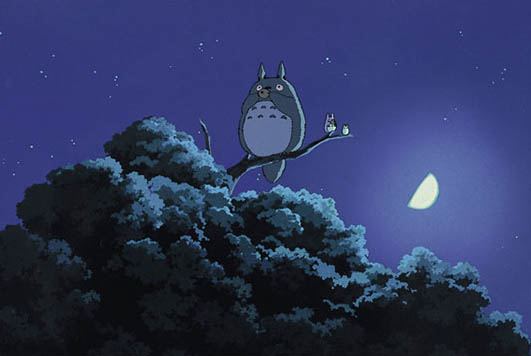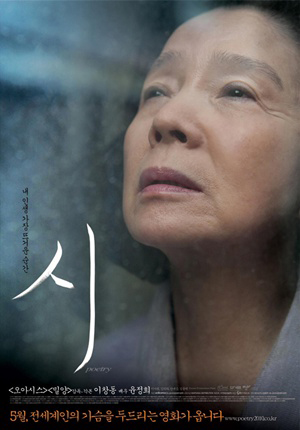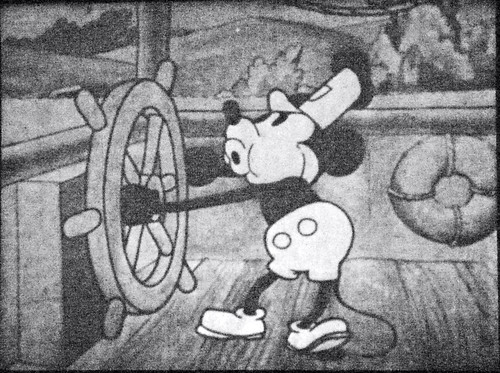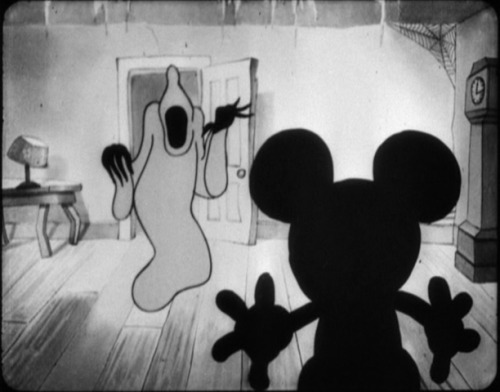I'll start off this review by simply stating that My Neighbour Totoro is one of the most delightful viewing experiences I've ever had the pleasure of having (if not the most delightful!). From the very start, viewers are introduced by a delightful introduction: an amber-colored title screen, with sprightly animated flowers, rocks, and woodland creatures along the edges. This is accompanied by a peppy background song, with Japanese lyrics that translate roughly to "Let's go for a walk! I love to walk! I have so many friends! I'm so happy!" It is from this point forward that I recognized that the film I was about to watch is atypical of any Disney film I was ever brought up with. I was about to watch a film of a more boundless, childlike aura.
The setting of the film is in a traditional village community in Japan, assumedly during the mid-20th century. Two young girls - Satsuki and her younger sister Mei - have moved in here with their father, in order to remain closer to their mother, who is at a hospital being treated for an unnamed illness. They soon discover that their house is "haunted"by tiny black creatures called "Dust Soots". Soon, Mei encounters two small rabbit-like creatures, who, when she follows them, lead her through the woods, into a large tree. There, she meets a much larger version of these creatures, who she calls "Totoro". The two sisters soon come to the conclusion that this large Totoro is the "keeper of the forest", and the rest of the film revolves their encounters with these whimsical spirits.
Anyone who had ever previously seen a film distributed by Studio Ghibli can expect at least one thing from their films; that being the beautiful animation that all of their films tend to embody. Luckily, My Neighbour Totoro accomplishes this wonderfully. From the birds-eye shots of the trees and clouds of the village, to the intricate detail placed in animating the creatures' faces and movements, the visuals are all-around completely breathtaking. It's no lie that Miyazaki's imagination is seemingly boundless; this could be seen in Spirited Away and Howl's Moving Castle, but I believe that its pinnacle truly lies with My Neighbour Totoro. Another thing to note is the simplistic mood and tone that this film so successfully carries. Unlike most Western children's films, this film does not attempt to spoon-feed some kind of moral message through overbearing tragedy or musical numbers. Although there are so many elements of fantasy, the characters of Satsuki and Mei seem so grounded into reality, that when drama does appear in the story, our feelings toward these characters are completely genuine.
If I had one word to describe this film, and one word alone, that word would be "magical". I don't believe I've ever seen another film that portrays the complete essence of childlike imagination as this one has. This film is, beyond all else, a tribute and homage to the limitlessness of child's imagination. At a certain point of the movie, it becomes apparent that these creatures can only really be seen by these two young girls. To me, this is perfect, because I think that such an imagination could only be exclusive to the innocence and naivety of a child. More importantly, this film is a recognition of how delights of imagination provide a sort of escape from the dismal and dreary. Satsuki and Mei use this new imaginative world of theirs to compensate for the ailing condition of their mother. Near the end of the film, when all hope seems lost, both of the girls turn to their new friends to help them look at the world in a new light, and suddenly, everything doesn't seem so bad.
Since its release in 1988, this film has become a classic among both young children and adults, and for very good reason. The film remains whimsical and charming enough to appeal to children, but with a dignified message and level of pathos that adults can appreciate at all. Moreover, the film is very beautiful to watch. Characters like Totoro and the Dust Soots truly capture what the essence of childhood and imagination is really all about - an escape from hardcore logic and an entrance into a magical world all your own. Because truthfully, the world of a child may be the most magical of them all.
My rating: 5/5
o3BPNBmuBV)w~~60_57.jpeg)





_02.jpg)







